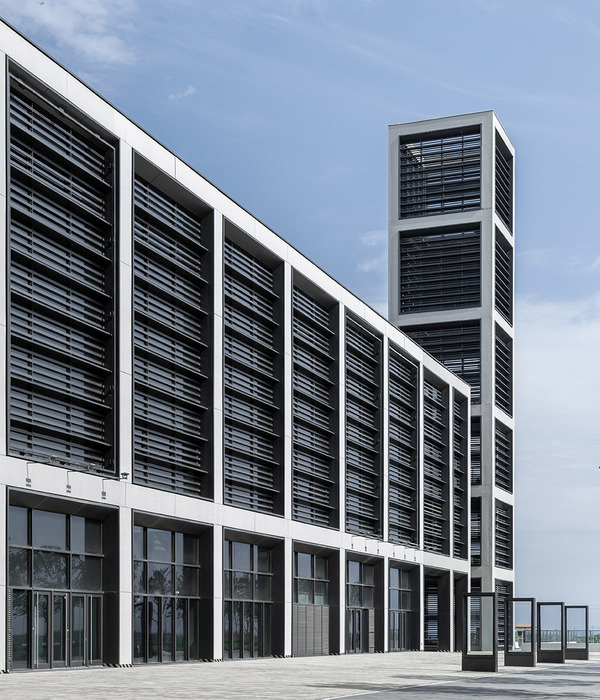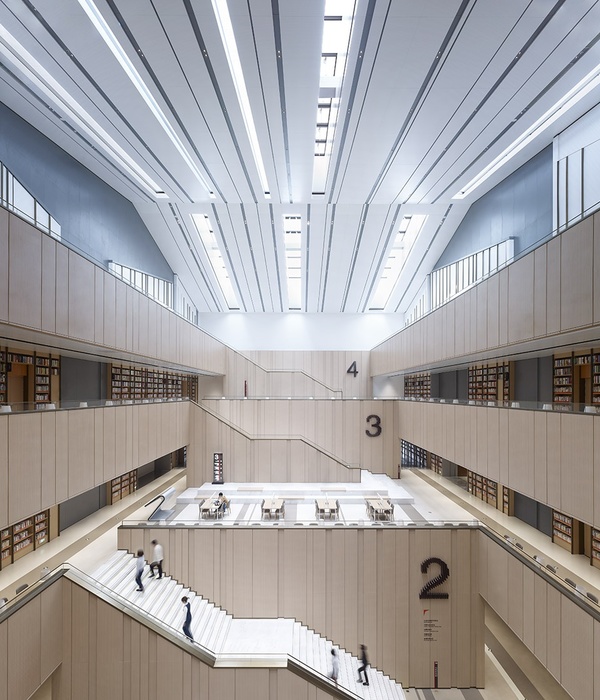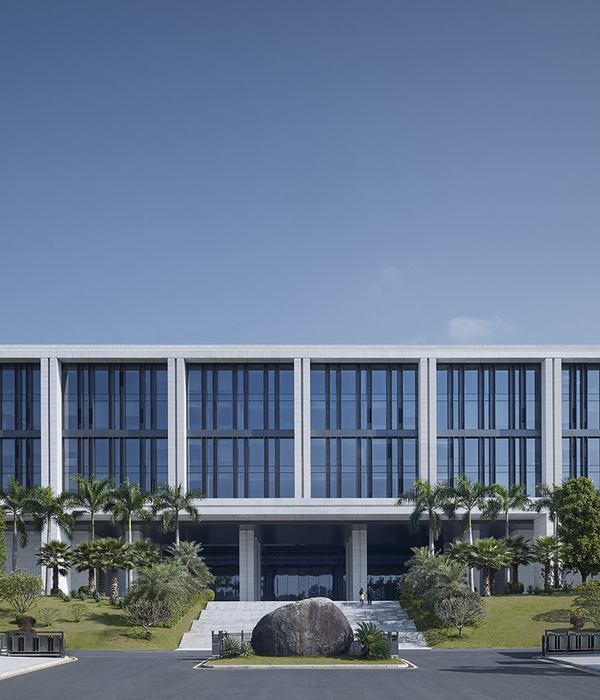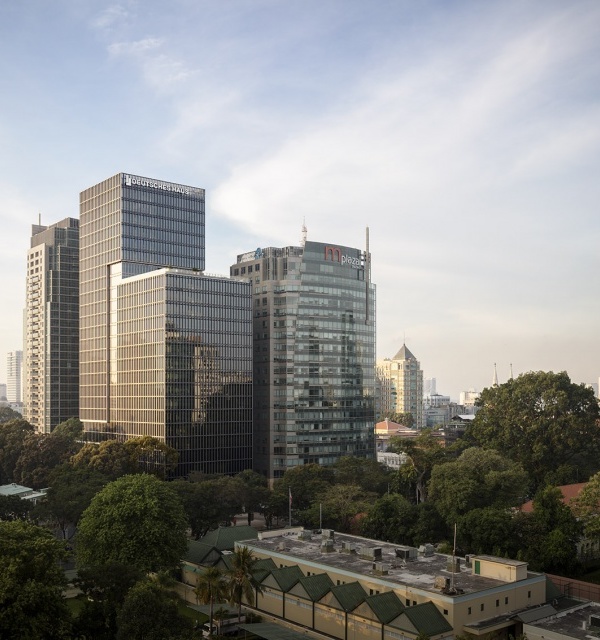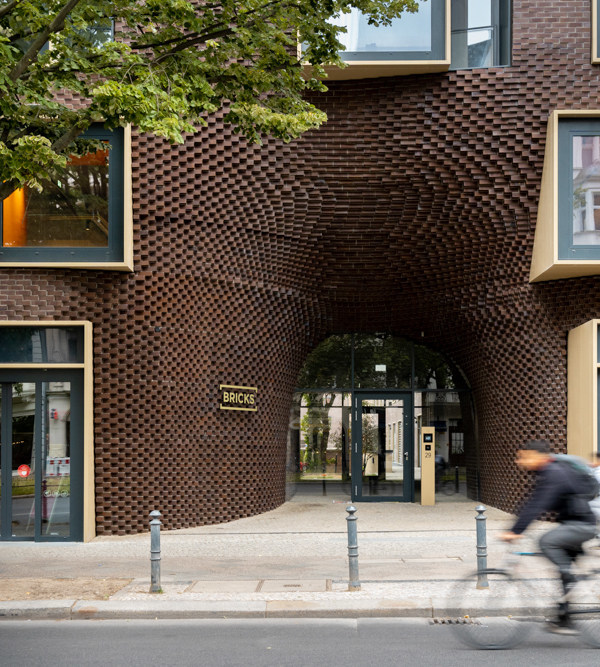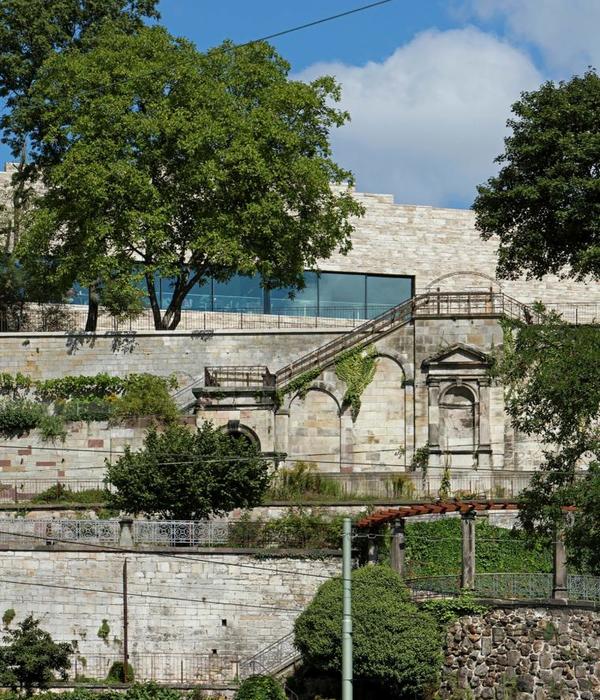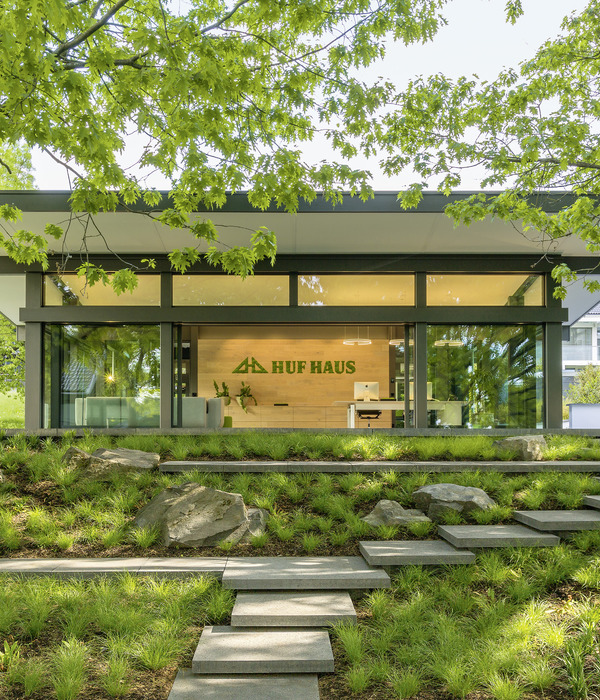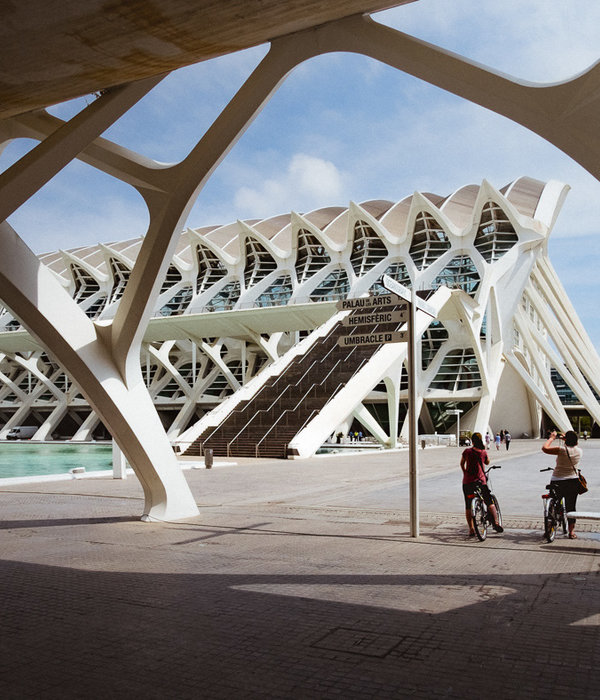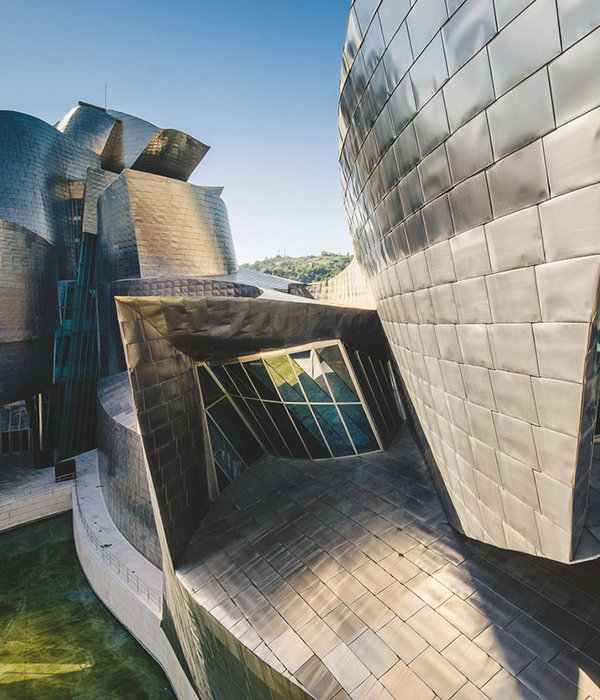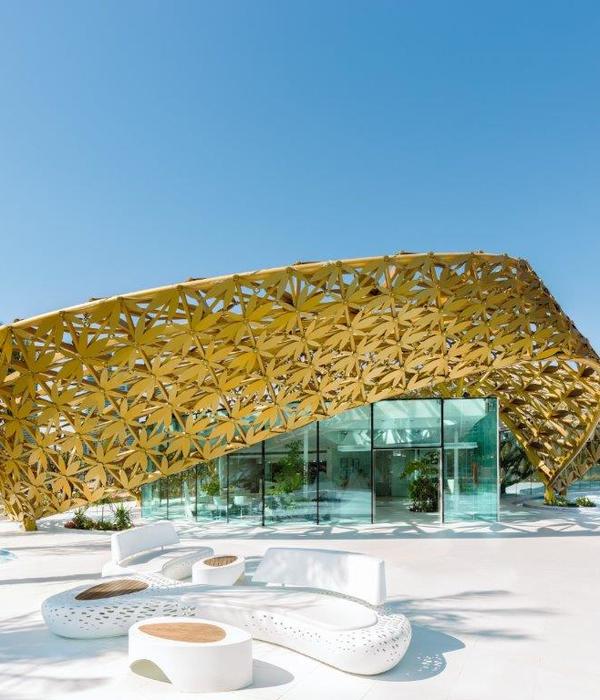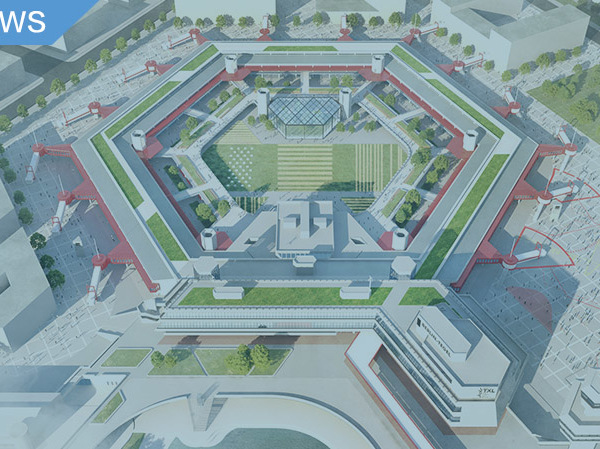项目背景
Project background
大庆西城公路客运综合枢纽站位于黑龙江省大庆市让胡路区,基地选址地处大庆西站北广场,整体建设用地6.77公顷,其中客运站主体站房建筑面积12780.35平方米。客运枢纽站由哈尔滨天宸建筑设计有限公司与A05工作室共同完成项目的建筑方案及深化设计,设计于2016年开始进行,项目在2022年8月建成竣工。大庆西城公路客运综合枢纽站是一次枢纽集群理念下的“零换乘”设计尝试,是对当下高铁站交通枢纽规划布局的一次创新性思考,公路与铁路站房最大限度利用各种交通线路,形成立体互通和功能互补,打造公铁联运的一体化整合设计。
Daqing West Integrated Highway Passenger Station is located in Ranghulu District, Daqing City, Heilongjiang Province. The specific site is on the north square of West Daqing Railway Station. The project covers a total land area of 6.77 hectares, including a station building area of 12780.35 square meters. Had Architects and Studio A05 jointly undertook the construction scheme and related design of the project. The design was started in 2016, and the project was completed in August 2022. Daqing West Integrated Highway Passenger Station is an attempt of “zero transfer” design under the concept of hub cluster, and innovative thinking about the planning layout of high-speed railway station transportation hubs. In the project, the highway station and the railway station use, to the greatest extent, various traffic lines to form an interconnected, complementary motor-rail multimodal transportation network.
▼项目概览,Overall view
公铁联运
Road-rail intermodal transport
由于国内高铁车站旅客运输量较大,铁路轨道交通与长途汽车、市内交通等运输体系往往毗邻规划,最终形成综合交通枢纽体系已经成为趋势。高铁枢纽中公路客运站的建设面临着与高铁站联建和连接等一系列问题,公铁联运概念也因此应运而生。公铁联运就是要整合铁路与公路两种交通资源,强化交通建筑组织的效率,形成联合运输模式的复合化交通枢纽。
公铁联运的场地布局和交通组织也有多种类型形式,在一些大型交通枢纽中也尝试过公铁整体建设的模式。而在大多数情况下,由于投资主体和建设部门等问题,公路客运站往往与铁路站房分别建设,公路客运站位于火车站广场的一侧或者附近,与火车站在室内外进行联系是当下的主导设计思路。
Since China’s high-speed railway stations face huge passenger transport volume, coaches, intracity transport and other transportation systems are commonly built near railway stations to finally form a comprehensive transportation hub system. The construction of a highway passenger station near a high-speed railway station involves co-construction or connection with the high-speed railway station. The concept of road-rail intermodal transport came into being under this background. Road-rail intermodal transport means integrating railway and highway transportation resources to improve the efficiency of the transportation construction organization and form a compound transportation hub.
There is more than one type of site layout and transportation organization for road-rail intermodal transport. The mode of building the highway station and the railway station as a whole has been tried in some large transportation hubs. In most cases, however, for the reason of the investor and the constructor, the highway station and the railway station are built separately. And the highway station is located on one side of or near the railway station square. Such indoor-outdoor interaction is a prevailing design idea at present.
▼场地黄昏鸟瞰,Aerial view of the site at dusk
轴线对接
Connection via axis
大庆西城公路客运综合枢纽站的规划建设是在大庆西站建成之后。大庆西站在最初设计中,在南广场形成了城市景观性广场,突出了大庆西站的城市标识特点。而大庆西站北广场多年处于未开发建设的状况,北广场区域的接送站和出站功能并没有开通。基于大庆西站南北广场的运营现状,设计团队在北广场公路客运枢纽站的设计过程中,大胆提出了公铁站房一体化设计思路,同时与南广场的城市景观功能相对应,在北广场突出以站房建筑为引导的城市交通集散功能。
The planning and construction of Daqing West Integrated Highway Passenger Station were after the completion of West Daqing Railway Station. In the initial design of West Daqing Railway Station, the South Square was made into a landscape square, highlighting the characteristics of West Daqing Railway Station as a landmark of the city. By contrast, the North Square of West Daqing Railway Station had been in an “undeveloped” state for years. The Pickup & Drop off and exit functions in North Square were not opened. Based on the operation status of the north and south squares of West Daqing Railway Station, the design team boldly put forward in the design process of the Integrated Highway Passenger Station on the North Square the integration of the railway and highway station buildings, and landscape and functions corresponding to the South Square. The urban traffic distribution function guided by the station building is highlighted on North Square.
▼建筑侧立面,Elevation
公路客运枢纽站的设计重新整合了火车站北广场地区的交通设施,将火车站的出站功能纳入到新建的客运枢纽站之中。公路客运枢纽站与火车站通过地下通道、地上连廊和地面广场进行立体化的连接,公铁两个站房通过中轴进行对接的模式在国内也是全新的尝试。
The design of the Integrated Highway Passenger Station reintegrates the transportation facilities on North Square, incorporating the exit function of the railway station into the newly built highway passenger station. The highway passenger station and the railway station are interconnected in a three-dimensional way– through an underground corridor, an above-ground corridor and a ground square. The buildings of the highway station and the railway station are linked up through a central axis. This was a new attempt across China.
▼北部主入口局部,Main entrance in the north facade
最终设计突出了既分又合的公铁功能融合,整合了接送站各种交通流线,围绕新建站房形成了各种交通车辆分区规划的清晰格局。客运站房内部形成中心大厅通道模式,通过室内南北通廊来打造火车站和公路客运站的进出站交通,同时中心大厅联系各部分室外交通功能,让旅客在行进过程有效的进行人流集散,进而进行各种交通工具出行的选择。
▼公铁对接剖面示意图
The combination of highway and railway functions
新老建筑关系
形体融合
Appearance blending
新建公路客运枢纽站的整体建筑形体依托大庆西站铁路站房,力争延续火车站形体关系的同时,也打造自身的形体特色。一方面,公路客运枢纽站站房采取了相对简约和低矮的天际线处理,同时通过曲线和斜线的形体应用与已建火车站相协调,设计依然突出大庆西站铁路站房的主导地位,形成建筑的组群特征;另一方面,公路站房是北广场的交通核心,进出火车站旅客也通过公路站房来进行各种交通分流,公路站房四个主要朝向面对了长途客车、公交车、出租车和私家车等不同交通功能,这使得建筑的形体处理更多是与交通车辆区域相配合,打造了更多的雨棚和屋面悬挑等形体元素,突出了建筑的交通枢纽功能特征。
The overall building shape of the newly built highway station relies on the building of West Daqing Railway Station, with an aim to continue the physical feature of the railway station building and meanwhile create its own physical characteristics. On the one side, the highway station building adopts a relatively simple and low skyline. Curves and oblique lines are used to coordinate with the railway station. The design retains the dominant position of West Daqing Railway Station and tries to embody the characteristics of a building complex; on the other hand, the highway station is the traffic core of North Square. Passengers entering/exiting the railway station are distributed through the highway station building. The highway station building faces coaches, buses, taxis and private cars in four directions. So the building shape is made to match different traffic vehicle zones. Many canopies and roof overhangs are arranged to highlight the functional characteristics of the building as a transportation hub.
长途车发车区,Long distance bus departure area
▼小型车落客区,Drop-off area for small vehicles
出租车等候区,Taxi waiting area
▼出租车道雨棚空间,Canopy of the taxi area
结构创新
Structural innovation
基于公路客运枢纽站的形体与功能定位,最终建筑的地面以上采取了全钢结构设计,突出建筑形体与结构的和谐统一。建筑主体通道空间与周边建筑雨棚的室内外形体处理相一致,在结构上采取了斜向Y型竖向支撑和曲线横向支撑相结合的方式,形成了室内外简洁而优美的结构设计语言。
Based on the shape and function positioning of the highway passenger station, a full-steel structure was finally adopted as the overground part to show the harmony and unity between shape and structure. The main passage space of the building is consistently treated with the indoor and outdoor shape of the surrounding canopies. In structure, a combination of oblique Y-type vertical support and curve horizontal support is adopted, forming a simple and beautiful structural design language indoors and outdoors.
▼室内中央通道,The central axis
▼入口门厅,Lobby hall
▼从二层看中央通道
View to the central axis from the second floor
▼钢结构序列,Steel structure sequence
▼Y型柱与曲线梁
Y-type vertical support and curve horizontal support
自动售票区
Self-service ticket area
室内的钢结构处理强化了建筑中心大厅的轴线性和丰富性,塑造了交通建筑空间的结构美学。公路站房和铁路站房之间通过钢结构室外连廊进行连接,室外连廊通过斜向钢柱进行竖向支撑,打造了灵活而轻盈的外部形体特色。
The indoor steel structure treatment enhances the axis property and richness of the central lobby and shapes the structural aesthetics of the traffic building space. The highway station building and the railway station building are connected by an outdoor steel structure corridor, which is vertically supported by oblique steel columns, creating a flexible and lightsome exterior appearance.
候车厅,Waiting hall
▼通往室外连廊的扶梯空间
Escalator leading to the outdoor corridor
扶梯一角,Escalator
▼从地下通道仰望大厅
Looking up to the main hall from the underground passage
▼二层临时候车厅,Temporary waiting hall
二层空间一角,2F space
▼钢结构细部
Steel structure close view
结语Conclusions
大庆西城公路客运综合枢纽站是一次交通组织优先的设计思考,建筑的功能、空间、形体和结构等要素都是围绕各种交通流线来进行的。公路站房已经打破了传统客运站的空间布局要求,形成了对铁路站房的功能延续设计,是一次公铁功能融合的分期建设尝试。本次设计中客运站房的场地布局和功能置入都突破了传统公铁联运的思考模式,拓展了公铁联运的空间类型和交通组织模式,为未来的铁路和公路综合枢纽发展提供了一些建设性的思路。
Daqing West Integrated Highway Passenger Station is a design idea of “traffic organization first”, because all of the function, space, shape, structure and other elements of the building are arranged to match various traffic streamlines. The design breaks through the spatial layout requirements of traditional passenger stations and realizes a functional continuation of the railway station building. It is a phased construction attempt under the integration of highway and railway functions. In this design, the site layout and the functional arrangement of the station building jump out of the traditional design thinking about road-rail intermodal transport, enriching the spatial types and traffic organization modes of road-rail intermodal transport, and providing constructive ideas for the future development of railway-highway integrated hubs.
▼建筑夜景局部,Facade view by night
▼建筑夜间全景,Overall view by night
▼钢结构施工,Steel structure
场地总平面图,Site plan
▼一二层平面图,Plan 1F and Plan 2F
▼剖面图,Sections
项目名称:大庆西城公路客运综合枢纽站
设计方:哈尔滨天宸建筑设计有限公司、A05工作室
公司网站:项目设计&完成年份:2016年/2022年
主创及设计团队:唐家骏、王博、王葱茏、张继春、董广海、张波涛、陈远望、邸云起、朱晓丽
项目地址:黑龙江省大庆市
建筑面积:12780.35平方米
摄影版权:韦树祥、唐家骏
客户:大庆市交通局
Project Name: Daqing West Integrated Highway Passenger Station
Design: Had Architects、Studio A05
Website:Design & Completion Year: 2016/2022
Leader Designer & Team: Tang Jiajun、Wang Bo、Wang Conglong、Zhang Jichun、Dong Guanghai、Zhang Botao、Chen Yuanwang、Di Yunqi、Zhu Xiaoli
Project Location: Daqing, Heilongjiang
Gross Built Area: 12780.35㎡
Photo cXredits: Wei Shuxiang、Tang Jiajun
Clients: Daqing Transportation Bureau
{{item.text_origin}}

